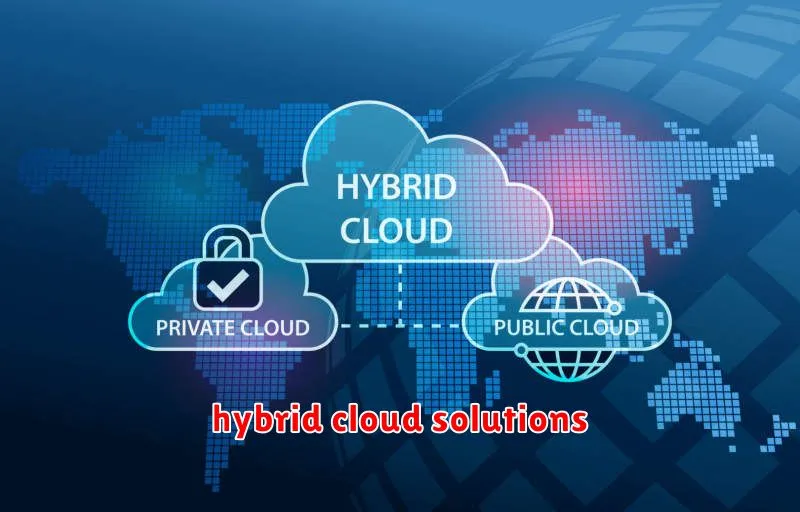In today’s rapidly evolving technological landscape, businesses are constantly seeking ways to optimize their operations, enhance efficiency, and gain a competitive edge. The rise of hybrid cloud solutions has emerged as a transformative force, offering the best of both worlds – the agility and scalability of the cloud combined with the security and control of on-premises infrastructure.
By seamlessly integrating on-premises and cloud resources, hybrid cloud empowers organizations to leverage the strengths of each environment, creating a truly flexible and powerful platform. Whether you’re looking to modernize your legacy systems, accelerate application development, or simply optimize resource utilization, hybrid cloud solutions can help you achieve your business objectives.
Understanding Hybrid Cloud: A Flexible Approach to Cloud Computing
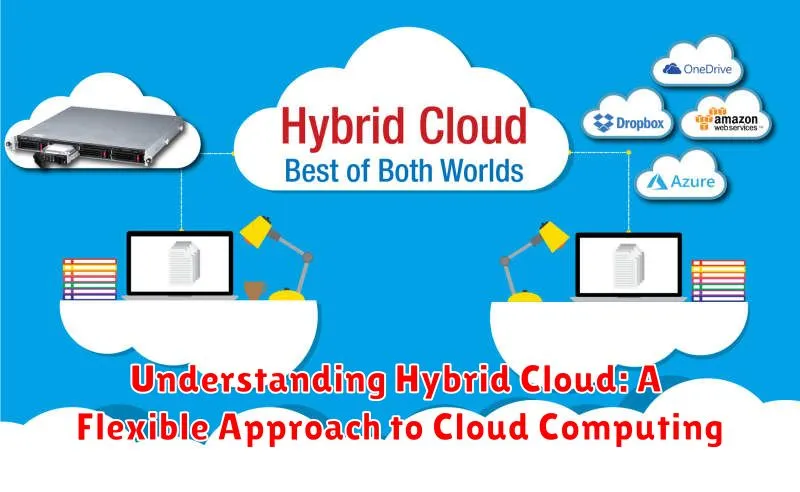
In the dynamic landscape of modern technology, organizations are constantly seeking innovative solutions to optimize their IT infrastructure. The rise of cloud computing has revolutionized how businesses operate, offering scalability, cost-effectiveness, and accessibility. However, transitioning entirely to a public cloud might not always be the ideal solution for every organization. Enter the hybrid cloud, a flexible and powerful approach that combines the best of both worlds.
A hybrid cloud model leverages the strengths of both public and private cloud environments. This strategic approach allows businesses to retain control over sensitive data and applications within their own private infrastructure while seamlessly integrating with the vast resources and agility of public cloud services. By deploying applications and workloads strategically across both environments, organizations gain unparalleled flexibility and scalability.
One of the key advantages of a hybrid cloud is its ability to optimize resource utilization. Businesses can allocate workloads to the most suitable environment based on specific requirements. For instance, mission-critical applications or data that require stringent security protocols can be hosted on the private cloud, while less critical applications or workloads with fluctuating demand can be seamlessly migrated to the public cloud. This dynamic allocation ensures optimal resource usage, maximizing efficiency and minimizing costs.
Moreover, hybrid clouds provide unparalleled flexibility and scalability. Organizations can easily adjust their infrastructure based on changing business needs, seamlessly scaling up or down resources as required. This agility enables businesses to respond quickly to market fluctuations, innovate rapidly, and maintain a competitive edge.
In conclusion, a hybrid cloud approach offers a powerful and versatile solution for organizations seeking to optimize their IT infrastructure. By combining the benefits of both public and private cloud environments, businesses can enjoy enhanced flexibility, scalability, and cost-effectiveness. This flexible model empowers organizations to leverage the strengths of both worlds, ultimately driving innovation and accelerating business growth.
Benefits of Hybrid Cloud for Enterprises
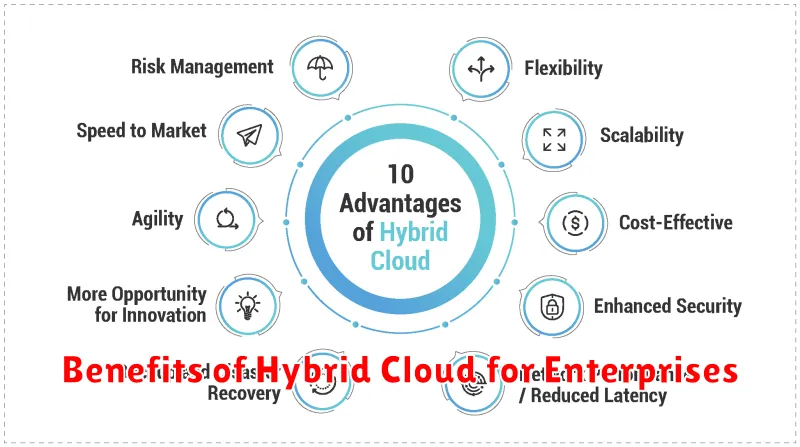
Hybrid cloud solutions offer a powerful combination of on-premises and public cloud resources, enabling businesses to leverage the best of both worlds. This approach provides numerous benefits for enterprises, driving flexibility, cost optimization, and enhanced security.
Flexibility and Scalability:
One of the key advantages of hybrid cloud is its ability to provide unparalleled flexibility and scalability. Enterprises can seamlessly allocate workloads to the most appropriate environment, leveraging on-premises infrastructure for mission-critical applications and public cloud for fluctuating demands. This dynamic approach allows businesses to scale resources up or down as needed, ensuring optimal performance and cost efficiency.
Cost Optimization:
Hybrid cloud solutions empower enterprises to optimize costs by leveraging the most cost-effective environment for each workload. By migrating less critical applications to the public cloud, businesses can reduce hardware and maintenance expenses. The pay-as-you-go model of public cloud services further allows for cost control by only paying for the resources utilized.
Enhanced Security:
Hybrid cloud environments provide robust security measures by combining the control and security of on-premises infrastructure with the advanced security features offered by public cloud providers. Enterprises can leverage dedicated security resources and implement comprehensive security policies across both environments, ensuring data protection and compliance.
Improved Disaster Recovery:
Hybrid cloud solutions offer enhanced disaster recovery capabilities by enabling businesses to replicate critical data and applications to the public cloud. In the event of a disaster, enterprises can quickly switch to the cloud infrastructure, minimizing downtime and ensuring business continuity.
Innovation and Agility:
By embracing hybrid cloud, enterprises gain access to a wider range of technologies and services, fostering innovation and agility. The flexibility and scalability of the hybrid model allow businesses to experiment with new technologies and quickly adapt to changing market conditions.
Use Cases: When Hybrid Cloud Makes Sense
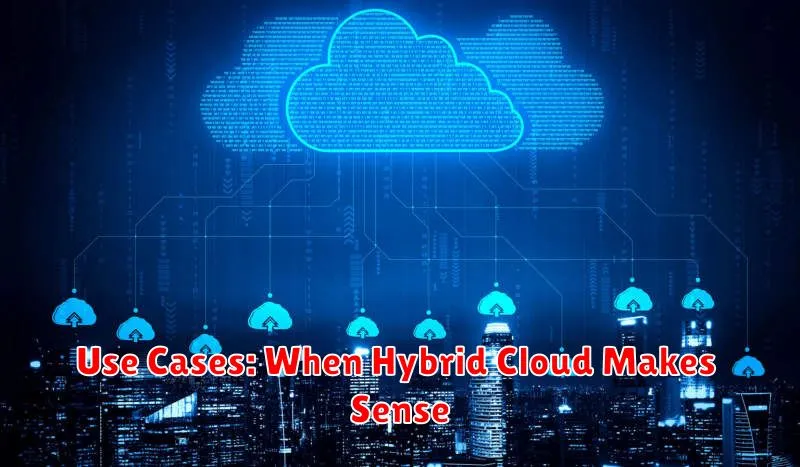
Hybrid cloud, a blend of public and private cloud environments, offers a compelling solution for businesses seeking the best of both worlds. This approach allows organizations to leverage the flexibility and scalability of public cloud services while maintaining control over sensitive data and critical applications within their own private cloud infrastructure.
Here are some specific use cases where hybrid cloud shines:
1. Legacy Application Modernization:
Organizations often struggle to modernize legacy applications due to their complex dependencies and integration challenges. Hybrid cloud provides a platform for migrating these applications to the cloud, gradually, without disrupting existing operations. It allows businesses to move specific workloads to the public cloud for cost optimization and scalability while keeping critical components within their private infrastructure.
2. Disaster Recovery and Business Continuity:
Hybrid cloud can be instrumental in establishing robust disaster recovery plans. By replicating critical data and applications to the public cloud, organizations can quickly restore operations in case of a disaster or outage affecting their private infrastructure. This ensures business continuity and minimizes downtime.
3. Bursting for Peak Demand:
For businesses experiencing seasonal or unpredictable spikes in demand, hybrid cloud offers an efficient solution. By leveraging public cloud resources during peak periods, organizations can scale their infrastructure dynamically without the need for large upfront investments. This allows them to handle surges in demand without compromising performance.
4. Cost Optimization and Resource Management:
Hybrid cloud allows for a balanced approach to resource management. Organizations can leverage the public cloud’s pay-as-you-go pricing model for non-critical workloads, while keeping sensitive data and mission-critical applications in their secure private environment. This can significantly reduce overall IT costs.
5. Regulatory Compliance:
Certain industries have stringent regulations regarding data security and privacy. Hybrid cloud enables organizations to comply with these regulations by keeping sensitive data and applications within their controlled private infrastructure while leveraging public cloud services for non-sensitive operations.
In summary, hybrid cloud offers a flexible and adaptable solution for various use cases. Whether it’s modernizing legacy applications, enhancing disaster recovery, managing peak demand, optimizing costs, or ensuring regulatory compliance, hybrid cloud empowers organizations to achieve their strategic objectives effectively.
Key Considerations for Implementing a Hybrid Cloud Strategy
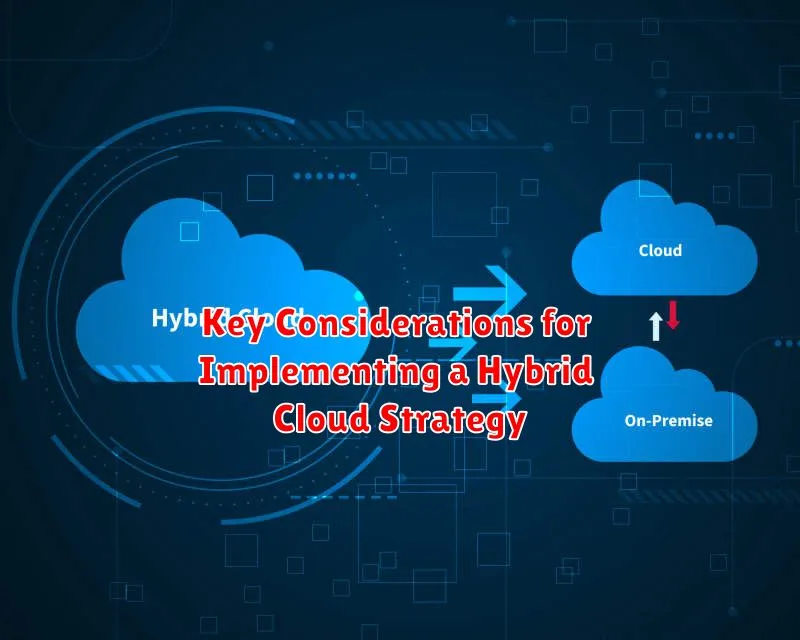
Embracing a hybrid cloud strategy can unlock significant benefits for your organization, combining the best of both public and private cloud environments. However, a successful transition requires careful planning and consideration of several key factors. This article delves into the essential aspects to consider when implementing your hybrid cloud strategy.
1. Define Your Business Objectives: Before diving into technical details, clearly define your business goals. Are you seeking cost optimization, increased agility, improved disaster recovery capabilities, or a combination of these? Aligning your hybrid cloud strategy with specific business objectives ensures you leverage the right resources and achieve desired outcomes.
2. Assess Your Existing Infrastructure: Thoroughly evaluate your current IT landscape. Identify applications and workloads that are ideal for migration to the public cloud, considering factors like scalability, performance requirements, and security needs. This assessment helps you determine the best fit for each application within your hybrid environment.
3. Choose the Right Cloud Providers: Select public cloud providers that align with your business needs and offer the necessary services and support. Consider factors like pricing, security compliance, data residency requirements, and integration capabilities with your existing infrastructure. Establishing clear SLAs and performance guarantees is crucial for a smooth transition.
4. Prioritize Connectivity and Security: Ensure seamless connectivity between your private and public cloud environments. This involves establishing robust network infrastructure and implementing strong security protocols to protect data and applications across both platforms. Consider using virtual private networks (VPNs), dedicated connections, or cloud-based security solutions.
5. Develop a Comprehensive Migration Plan: A well-defined migration plan outlines the steps involved in moving workloads to the hybrid cloud, including data migration, application reconfiguration, and testing. Establishing clear timelines, assigning responsibilities, and managing potential risks are vital for a successful transition.
6. Optimize Cost Management: Hybrid cloud solutions offer flexibility, but effective cost management is essential. Develop strategies for monitoring resource usage, optimizing cloud service utilization, and leveraging cost-effective pricing models. Implementing tools for cloud cost analysis and automation can help you manage expenses effectively.
7. Continuously Monitor and Adapt: The hybrid cloud environment is dynamic. Implement monitoring tools to track performance, security, and cost metrics across both public and private cloud components. Continuously evaluate your strategy, adapt to changing business needs, and make necessary adjustments to optimize performance and efficiency.
Choosing the Right Cloud Providers and Services
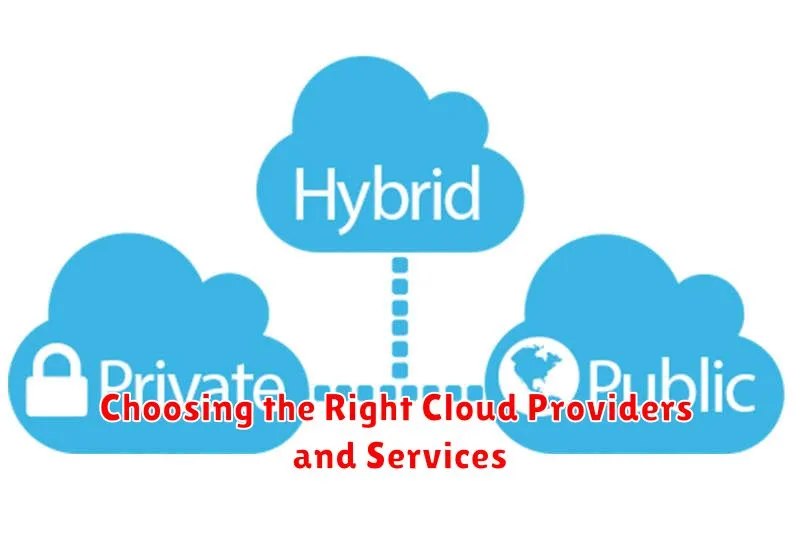
Adopting a hybrid cloud strategy can offer significant benefits, but choosing the right cloud providers and services is crucial for maximizing its potential. Consider these key factors when making your decision:
1. Understanding Your Needs
Before selecting providers, clearly define your business requirements. Determine the applications and workloads you plan to migrate, their performance and security needs, and the level of flexibility and scalability required. This will help you narrow down the most suitable cloud services.
2. Evaluating Provider Capabilities
Research and evaluate potential cloud providers based on their infrastructure, services, and expertise. Look for providers that offer a comprehensive suite of services, including compute, storage, networking, security, and management tools. Consider factors like:
- Region and Availability Zones: Ensure the provider has a presence in your desired location and offers robust disaster recovery capabilities.
- Compliance and Security Standards: Verify their adherence to industry-specific regulations and security certifications.
- Service Level Agreements (SLAs): Evaluate the guaranteed uptime and performance levels offered.
- Pricing Models: Compare different pricing models (pay-as-you-go, reserved instances, etc.) to find the most cost-effective option.
3. Assessing Integration and Compatibility
Evaluate how seamlessly the cloud provider’s services integrate with your existing on-premises infrastructure and applications. Consider the API compatibility, data migration tools, and support for existing technologies. Ensure a smooth transition and minimize disruption to your operations.
4. Evaluating Support and Expertise
Choose providers with strong support offerings, including technical expertise, customer service, and documentation. Evaluate their response times, proactive monitoring capabilities, and ability to handle complex issues.
Data Management and Security in a Hybrid Cloud Environment
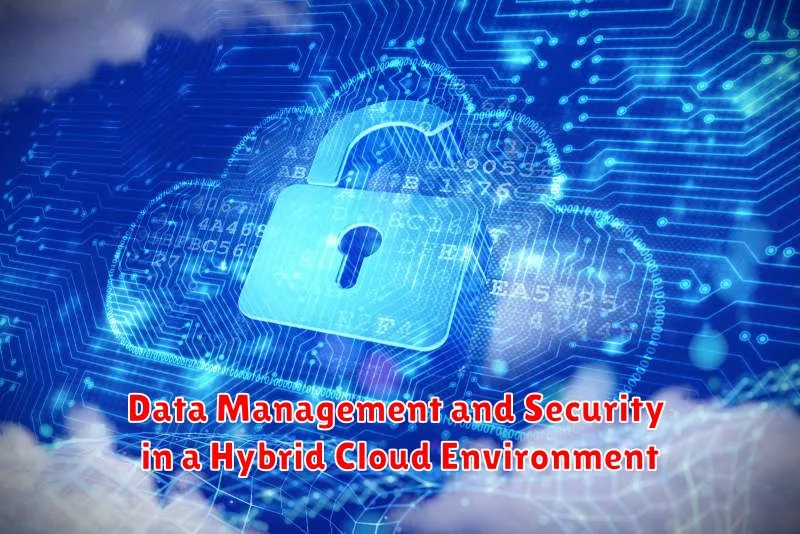
Hybrid cloud solutions offer the best of both worlds, combining the flexibility and scalability of public clouds with the security and control of on-premises infrastructure. However, this combination also presents unique challenges for data management and security. Here’s how to effectively manage and secure your data in a hybrid cloud environment:
Data Visibility and Management: One of the key challenges in hybrid cloud environments is ensuring visibility and control over your data across multiple platforms. This requires a comprehensive data management strategy that encompasses both on-premises and cloud data. Utilize tools that provide centralized visibility and control over data, including data discovery, classification, and governance capabilities.
Data Security: Security is paramount in any cloud environment, and hybrid cloud adds another layer of complexity. Implementing robust security measures is crucial. This includes:
- Encryption: Encrypt data at rest and in transit to protect it from unauthorized access. This is essential for both on-premises and cloud data.
- Access Control: Implement strong access controls to restrict access to sensitive data, both internally and externally.
- Network Security: Secure network connectivity between on-premises and cloud environments to prevent data breaches.
- Compliance and Governance: Ensure compliance with relevant regulations and industry standards for data privacy and security.
Disaster Recovery and Business Continuity: A well-defined disaster recovery plan is essential in hybrid cloud environments. Ensure that your data is backed up regularly and that you have a plan to restore data in case of a disaster or outage. Consider using cloud-based backup and recovery solutions to protect your data across multiple locations.
Security Monitoring and Response: Implement continuous monitoring and threat detection systems to identify and respond to potential security threats. This includes both on-premises and cloud security monitoring tools. Establish clear incident response procedures and ensure that your team is well-trained to handle security incidents effectively.
By adopting a comprehensive approach to data management and security in your hybrid cloud environment, you can reap the benefits of this innovative solution while mitigating risks and protecting your valuable data.
Integration and Interoperability: Connecting Your Clouds
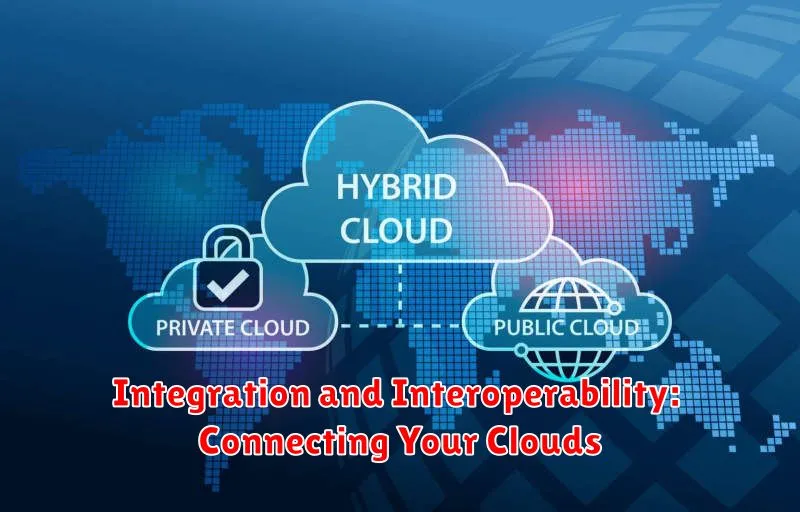
The beauty of hybrid cloud solutions lies in their ability to seamlessly integrate various cloud environments. This integration allows organizations to reap the benefits of both public and private clouds, optimizing their infrastructure and applications for maximum efficiency and cost-effectiveness. But how do these different clouds connect and communicate? This is where integration and interoperability come into play.
Integration refers to the process of connecting different cloud services, applications, and data sources. This can be achieved through various means, such as APIs, message queues, and data synchronization tools. Effective integration ensures that data flows smoothly between different clouds, enabling seamless operation and collaboration.
Interoperability goes a step further, focusing on the ability of different cloud platforms to interact and exchange information in a standardized way. This requires adherence to common protocols and standards, allowing for a more cohesive and efficient hybrid cloud ecosystem. Interoperability is crucial for creating a unified experience across different cloud environments, minimizing complexities and maximizing compatibility.
When choosing a hybrid cloud solution, it’s essential to prioritize integration and interoperability. Look for providers that offer robust tools and mechanisms for connecting different cloud services and ensuring smooth data flow. By embracing these principles, organizations can harness the true power of hybrid cloud, seamlessly integrating their public and private cloud resources for a dynamic and adaptable infrastructure.
Managing Costs and Optimizing Resources
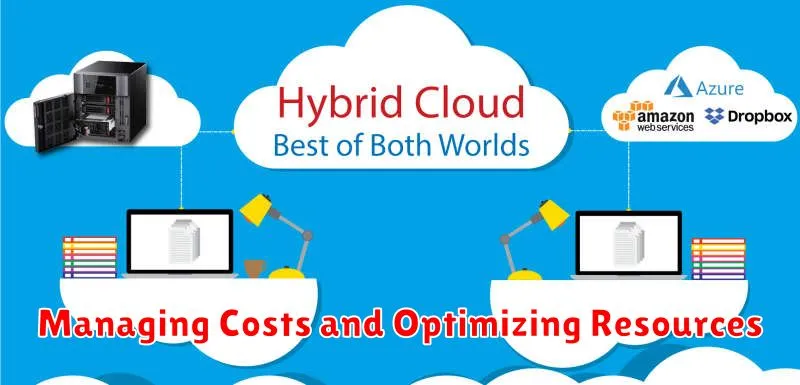
Hybrid cloud solutions offer a powerful approach to optimizing resource allocation and managing costs. By strategically distributing workloads between on-premises infrastructure and cloud services, businesses can achieve a delicate balance between cost savings and performance optimization.
One of the key benefits of hybrid cloud is the ability to leverage pay-as-you-go cloud services for dynamic workloads, such as seasonal peaks or new product launches. This eliminates the need for large upfront investments in hardware and infrastructure, enabling businesses to scale resources up or down as needed. This flexible approach minimizes unnecessary spending and ensures that resources are used efficiently.
Hybrid cloud also empowers businesses to optimize their existing on-premises infrastructure. By migrating less critical or seasonal workloads to the cloud, organizations can free up capacity on their on-premises servers, potentially reducing their hardware footprint and associated costs. This allows businesses to prioritize resources for mission-critical applications and maximize the utilization of their existing investments.
Moreover, hybrid cloud solutions offer enhanced resource optimization through cloud automation and orchestration tools. These tools allow businesses to automate the deployment, scaling, and management of resources across both on-premises and cloud environments, further improving efficiency and reducing manual intervention. This streamlined approach minimizes operational costs and ensures that resources are consistently allocated to meet changing demands.
By strategically combining the benefits of both on-premises and cloud environments, hybrid cloud solutions provide a powerful means of managing costs and optimizing resources. This approach offers flexibility, scalability, and cost-efficiency, empowering businesses to make informed decisions about their infrastructure and achieve a balance between performance and affordability.
Future Trends: The Evolving Landscape of Hybrid Cloud
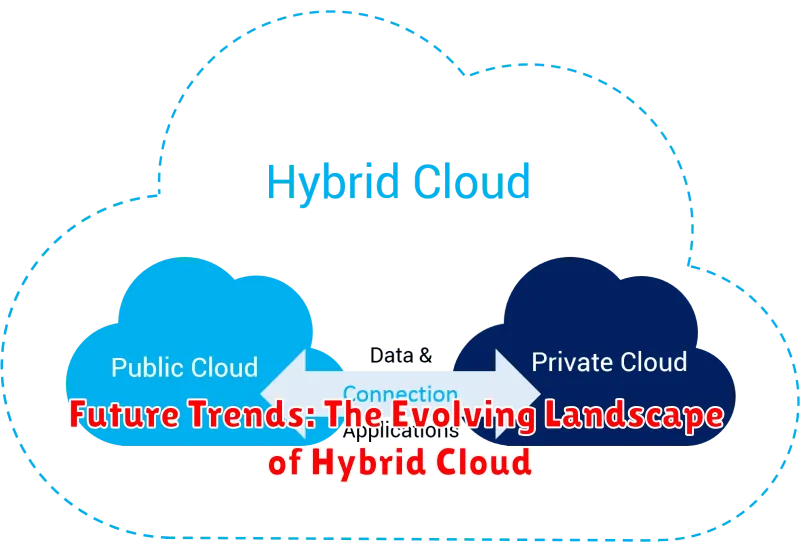
The hybrid cloud has emerged as a dominant force in the IT landscape, offering businesses the flexibility and agility of cloud computing while retaining the security and control of on-premises infrastructure. As technology continues to evolve, we can expect to see several exciting trends shaping the future of hybrid cloud solutions.
One key trend is the rise of multi-cloud, where organizations leverage multiple cloud providers to enhance flexibility, redundancy, and cost optimization. This strategy allows businesses to select the best cloud services for specific workloads and avoid vendor lock-in.
Another crucial development is the increasing adoption of edge computing, which brings computation and data storage closer to users and devices. This enables faster data processing, lower latency, and improved user experiences. Hybrid cloud solutions play a vital role in supporting edge deployments, providing centralized management and orchestration for distributed edge resources.
Furthermore, the convergence of artificial intelligence (AI) and machine learning (ML) is transforming how hybrid cloud environments operate. AI-powered tools can automate tasks, optimize resource utilization, and enhance security by detecting and responding to threats proactively.
As we move forward, the hybrid cloud landscape will continue to evolve, driven by innovation and changing business demands. Organizations that embrace these emerging trends and leverage the power of hybrid cloud solutions will be well-positioned to achieve their digital transformation goals and stay ahead of the competition.

